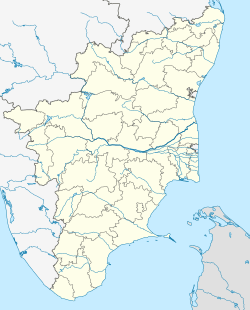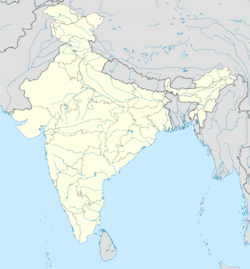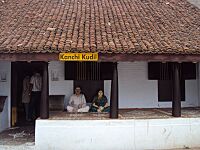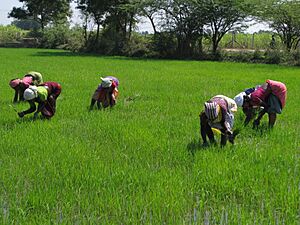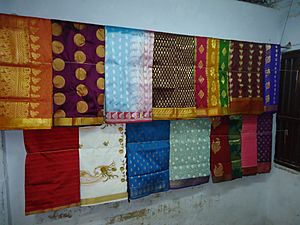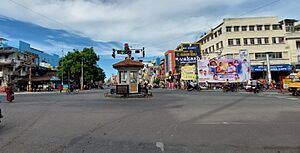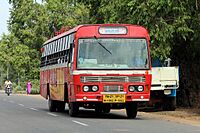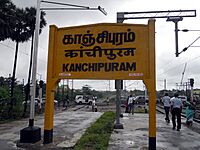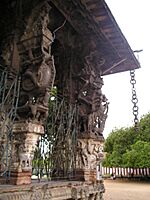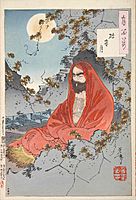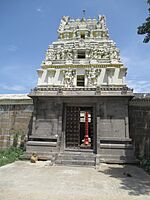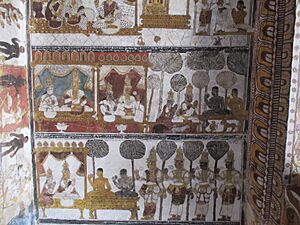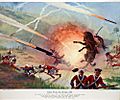Kanchipuram facts for kids
Quick facts for kids
Kanchipuram
Conjeevaram
|
|
|---|---|
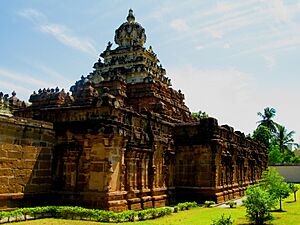
Vaikunta Perumal Temple, (731 CE–796 CE), one of the oldest temple in the city
|
|
| Nickname(s):
Spiritual Capital of Tamil Nadu,City of Thousand Temples, Silk City, Temple City, Capital of Pallava Nadu
|
|
| Country | |
| State | Tamil Nadu |
| Region | Tondai Nadu |
| District | Kanchipuram |
| Established | 300 BCE |
| Government | |
| • Type | Mayor-Council |
| • Body | Kanchipuram Municipal Corporation |
| Area | |
| • Total | 112.4 km2 (43.4 sq mi) |
| Area rank | 15 |
| Elevation | 105 m (344 ft) |
| Population
(2011)
|
|
| • Total | 284,561 |
| • Rank | 15 |
| • Density | 2,531.7/km2 (6,557.0/sq mi) |
| Demonym(s) | kanchipuramites |
| Languages | |
| • Official | Tamil |
| Time zone | UTC+5:30 (IST) |
| PIN |
631501-631503
|
| Telephone code | 044 |
| Vehicle registration | TN-21 |
Kanchipuram is an important city in the Indian state of Tamil Nadu. It is located about 72 kilometers (45 miles) from Chennai, the capital of Tamil Nadu. People often call Kanchipuram the City of Thousand Temples because it has many ancient and beautiful temples.
This city is famous for its amazing temple designs, huge temple towers, and especially its beautiful silk saris. Kanchipuram is a popular place for tourists, both from India and other countries. The city covers an area of about 36.14 square kilometers (13.95 sq mi). In 2021, its population was estimated to be over 1.3 million people. It is also the main office for the Kanchipuram District. You can easily reach Kanchipuram by road and train.
The name Kanchipuram comes from two Sanskrit words: "Kanchi" (meaning Brahma worship) and "puram" (meaning residential place). The city is built near the Vegavathy and Palar rivers. Many different kingdoms have ruled Kanchipuram over time, including the Pallavas, Medieval Cholas, Later Cholas, Pandyas, Vijayanagara Empire, and the British. The British used to call it "Conjeeveram."
Kanchipuram has many historic buildings, like the Kailasanathar Temple and the Vaikunta Perumal Temple. Long ago, Kanchipuram was a famous center for learning, known as a ghatikasthanam. It was also an important religious and education hub for Jainism and Buddhism between the 1st and 5th centuries.
In Vaishnavism (a branch of Hinduism), Kanchipuram is one of the seven holy places called Tirtha where people believe they can find spiritual freedom. The city has several major Hindu temples, such as Varadharaja Perumal Temple, Ekambareswarar Temple, Kamakshi Amman Temple, and Kumarakottam Temple. Out of 108 very holy temples dedicated to the Hindu god Vishnu, 15 are in Kanchipuram.
The city is very important for Sri Vaishnavism, Shaktism, and Shaivism. Many people in Kanchipuram work in the silk weaving industry. Kanchipuram is managed by a special city government that was set up in 1947. It is also home to the Kanchi matha, a Hindu religious center believed to have been started by the saint Adi Sankaracharya. Kanchipuram was the capital city of the Pallava kingdom from the 4th to the 9th centuries.
The Indian government has chosen Kanchipuram as one of its heritage cities for the HRIDAY - Heritage City Development and Augmentation Yojana plan.
Contents
Understanding the Name of Kanchipuram
Kanchipuram was known as Kanchi or Kachipedu in old Tamil and Sanskrit writings. In Sanskrit, the word "Kanchi" can be split into "ka" and "anchi." "Ka" means Brahma, and "anchi" means worship. This shows that Kanchi is the place where Varadharaja Perumal was worshipped by Brahma. Brahma himself created the Athi Varadhar idol and worshipped it here.
Another Sanskrit meaning for Kanchi is "girdle," suggesting the city is like a belt around the earth. The oldest Sanskrit writings from the Gupta Empire (early 4th to late 5th century CE) call the city Kanchipuram. The ancient writer Patanjali (around 150 BCE) also mentioned the city as Kanchipuraka in his book Mahabhasya.
Over time, the city was called by different names like Kanchi, Kanchipedu, and Kanchipuram. During British rule, it was known as Conjeevaram. Today, the local government uses the name Kancheepuram, but the district and city are still called Kanchipuram.
Kanchipuram's Rich History
The earliest mentions of Kanchipuram are found in the writings of the Sanskrit grammarian Patanjali, who lived between the 3rd and 2nd centuries BCE. The famous poet Kalidasa (4th century) called Kanchipuram "the best among cities." The city is also mentioned in ancient Tamil writings like Manimegalai and Perumpāṇāṟṟuppaṭai from around 300 BCE.
Pallava Rule: A Golden Age
Kanchipuram became very important when the Pallavas made it their capital in the 6th century. The Pallava kings built strong walls, wide moats, and beautiful temples. During the rule of King Mahendravarman I, the city faced invasions but was successfully defended. King Narasimhavarman I even defeated the Chalukya king Pulakesin II.
Under the Pallavas, Kanchipuram became a major center for Hindu and Buddhist learning. King Narasimhavarman II built important Hindu temples like the Vaikuntha Perumal Temple and Kanchi Kailasanathar Temple. A Chinese traveler named Xuanzang visited Kanchipuram in 640 CE. He wrote that the city was about 6 miles (9.7 km) around and its people were known for their bravery and love of learning.
Chola and Vijayanagara Empires
Later, the Chola king Aditya I conquered Kanchipuram around 890 CE. Under the Cholas, the city was an important regional center. King Raja Raja Chola I built the Karchapeswarar Temple. His son, Rajendra Chola I, built the Yathothkari Perumal Temple.
In 1361, the Vijayanagara Empire took control of Kanchipuram. They ruled the city until 1645. Kings like Krishna Deva Raya, one of the greatest Vijayanagara rulers, visited Kanchipuram and made many donations to the temples. His inscriptions, written in four languages, show how much the kings cared for the shrines.
Later Rulers and British Influence
After the Vijayanagara Empire fell, Kanchipuram went through a period of political changes. The Golconda Sultanate and then Bijapur controlled the city for a short time. In 1687, the Mughal Empire took over Kanchipuram. During this time, temple priests even moved idols to protect them from damage.
Kanchipuram was also a battleground during the Carnatic Wars between the British and French, and the Anglo-Mysore Wars. The famous Battle of Pollilur, where Hyder Ali used rockets, happened near Kanchipuram. In the late 1700s, the British East India Company gained control of the area. They made Kanchipuram the capital of the new Kanchipuram district in 1997.
Kanchipuram's Location and Environment
Kanchipuram is located about 72 kilometers (45 miles) southwest of Chennai. It sits on the banks of the Vegavathi River, which flows into the Palar River. The city is about 83.2 meters (273 feet) above sea level. The land around Kanchipuram is mostly flat.
The soil in the area is mainly clay, which is good for building. It's thought that the granite used for the Varadaraja Perumal Temple came from the Sivaram Hills, about 10 miles (16 km) east of the city. Kanchipuram is in a Seismic Zone II region, meaning small earthquakes might happen.
Kanchipuram is divided into two main parts:
- Big Kanchi (also called Shiva Kanchi): This is the western and larger part of the city. Most of the Shiva temples are here.
- Little Kanchi (also called Vishnu Kanchi): This is on the eastern side of the city. Most of the Vishnu temples are here.
Groundwater from canals, tanks, and wells is the main source of water for farming. The area is also home to special medicinal plants.
Kanchipuram's Climate
Kanchipuram has a tropical wet and dry climate, which means it's generally healthy.
- Temperatures: The hottest months are from April to July, with average highs around 37.5°C (99.5°F). The coolest months are December to February, with average lows around 16°C (60.8°F).
- Humidity: The air is usually humid, especially in the mornings. It's most humid from November to January and least humid in June.
- Rainfall: Most of the rain comes from storms in the Bay of Bengal during the northeast monsoon. Kanchipuram gets rain from both the Northeast and Southwest monsoons. In 2015, Kanchipuram district received the highest rainfall in Tamil Nadu during the Northeast Monsoon season. On November 13, 2015, the city had a huge 340 mm (13 in) of rain, causing serious flooding.
| Climate data for Kanchipuram, Tamil Nadu | |||||||||||||
|---|---|---|---|---|---|---|---|---|---|---|---|---|---|
| Month | Jan | Feb | Mar | Apr | May | Jun | Jul | Aug | Sep | Oct | Nov | Dec | Year |
| Mean daily maximum °C (°F) | 29.1 (84.4) |
31.2 (88.2) |
33.4 (92.1) |
35.6 (96.1) |
38.2 (100.8) |
37.2 (99.0) |
35.2 (95.4) |
34.7 (94.5) |
34.1 (93.4) |
32.1 (89.8) |
29.3 (84.7) |
28.5 (83.3) |
33.2 (91.8) |
| Mean daily minimum °C (°F) | 19.2 (66.6) |
19.8 (67.6) |
22.0 (71.6) |
25.4 (77.7) |
27.3 (81.1) |
27.0 (80.6) |
25.9 (78.6) |
25.4 (77.7) |
24.8 (76.6) |
23.7 (74.7) |
21.6 (70.9) |
19.9 (67.8) |
23.5 (74.3) |
| Average rainfall mm (inches) | 25 (1.0) |
6 (0.2) |
4 (0.2) |
19 (0.7) |
59 (2.3) |
77 (3.0) |
108 (4.3) |
173 (6.8) |
132 (5.2) |
185 (7.3) |
209 (8.2) |
107 (4.2) |
1,104 (43.4) |
| Source: Climate-Data.org | |||||||||||||
People and Population of Kanchipuram
| Historical population | ||
|---|---|---|
| Year | Pop. | ±% |
| 1871 | 37,275 | — |
| 1881 | 37,312 | +0.1% |
| 1891 | 42,547 | +14.0% |
| 1901 | 46,164 | +8.5% |
| 1911 | 53,864 | +16.7% |
| 1921 | 61,376 | +13.9% |
| 1931 | 65,258 | +6.3% |
| 1941 | 74,685 | +14.4% |
| 1951 | 84,810 | +13.6% |
| 1961 | 92,714 | +9.3% |
| 1971 | 110,657 | +19.4% |
| 1981 | 131,013 | +18.4% |
| 1991 | 144,955 | +10.6% |
| 2001 | 153,140 | +5.6% |
| 2011 | 164,265 | +7.3% |
Sources:
|
||
In the 7th century, during King Narasimha Varma's rule, Kanchipuram had about 10,000 people. The city grew, and houses were built on raised platforms with good ventilation.
By the 1901 British census, Kanchipuram had a population of 46,164. Most people were Hindus, with smaller numbers of Muslims, Christians, and Jains.
| Religious census | ||||
|---|---|---|---|---|
| Religion | Percent(%) | |||
| Hindu | 93.38% | |||
| Muslim | 5.24% | |||
| Christian | 0.83% | |||
| Jain | 0.4% | |||
| Sikh | 0.01% | |||
| Buddhist | 0.01% | |||
| Other | 0.11% | |||
| No religion | 0.01% | |||
According to the 2011 census, Kanchipuram had 164,384 people. There were slightly more females than males. About 15,955 children were under six years old. The city's literacy rate (people who can read and write) was 79.51%, which is higher than the national average.
Most people in Kanchipuram are Hindus (93.38%), followed by Muslims (5.24%), Christians (0.83%), and Jains (0.4%). About 800,000 pilgrims visit the city every year.
The city has many homes, especially around the temples. Commercial areas, like shops and businesses, cover about 62 hectares (150 acres). Industrial areas, where silk weaving, dyeing, and rice production happen, cover about 65 hectares (160 acres).
Kanchipuram's Economy

The main jobs in Kanchipuram are silk sari weaving and farming. In 2008, about 5,000 families worked in sari production. Other important industries include cotton production, making light machinery and electrical goods, and food processing. There are many silk and cotton yarn factories, dyeing units, and rice mills in the city. Tourism is also a big part of the economy, with many hotels, restaurants, and local transport services.
Kanchipuram Silk Sarees
Kanchipuram is famous for its traditional silk weaving and handloom industries, which produce the beautiful Kanchipuram Sarees. This industry is worth a lot of money. In 2005, "Kanchipuram Silk Sarees" received a special "Geographical Indication" tag. This means they are recognized as a unique product from this specific region.
The silk trade started in Kanchipuram when King Raja Raja Chola I (985–1014) invited weavers from Saurashtra, Gujarat, to move to Kanchi. The craft grew even more in the 15th century when many weavers from Andhra Pradesh came during the Vijayanagara rule.
Many major banks in India have branches in Kanchipuram, including State Bank of India and ICICI Bank. They also have ATMs throughout the city.
Getting Around Kanchipuram
The National Highway 4, which connects Chennai and Bangalore, passes near Kanchipuram. The Tamil Nadu State Transport Corporation provides daily bus services to and from many cities like Chennai, Bangalore, and Tirupati. There are two main bus routes to Chennai. Local bus services are also available within the city.
Kanchipuram is also connected by train. The Kanchipuram railway station is on the Chengalpet–Arakkonam railway line. You can take daily trains to Pondicherry and Tirupati, and there are also express trains to Madurai and Nagercoil.
The closest airport is Chennai International Airport, which is about 72 km (45 miles) away. A new international airport is planned to be built in Parandhur, near Kanchipuram.
Communication and City Services
Bharat Sanchar Nigam Limited (BSNL), a government company, provides telephone and internet services. The Tamil Nadu Electricity Board (TNEB) supplies electricity. The Kanchipuram municipality provides water, which comes from underground springs of the Vegavati river.
About 55 tonnes of waste are collected from the city every day. Kanchipuram also has an underground sewage system that was put in place in 1975.
Learning in Kanchipuram
Kanchipuram has always been a center for religious education for Hindus, Jains, and Buddhists. Buddhist monasteries were important places for learning. When Hinduism became popular again during the rule of Mahendra Varman I, Hindu education grew, and Sanskrit became the official language.
As of 2011, Kanchipuram has 49 registered schools. The city government runs 16 of these schools. There are also night schools for children who work in the silk weaving industry.
Larsen & Toubro opened India's first training center for rail construction in Kanchipuram in 2012. It can train many technicians, managers, and engineers each year.
Kanchipuram is home to two Deemed universities: Sri Chandrasekharendra Saraswathi Viswa Mahavidyalaya and Chettinad Academy of Research and Education (CARE). The famous Pachaiyappa's College for Men, founded 65 years ago, is also here.
The city has one of the four Indian Institute of Information Technology centers, which offers courses in information technology. Kanchipuram also has two medical colleges, six engineering colleges, three polytechnic institutes, and six arts and science colleges.
Religions in Kanchipuram
Hinduism: A City of Temples
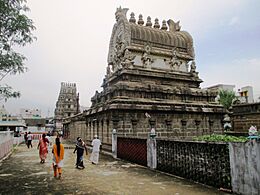
Hindus consider Kanchipuram to be one of the seven holiest cities in India, known as the Sapta Puri. It is believed that visiting these cities can help people achieve spiritual freedom (moksha). Kanchipuram is a pilgrimage site for followers of both Vaishnavites (who worship Vishnu) and Saivites (who worship Shiva).
Varadharaja Perumal Temple
Varadharaja Perumal Temple, dedicated to Maha Vishnu, is the largest Vishnu temple in Kanchipuram, covering 23 acres (9.3 hectares). It has about 350 inscriptions from different kingdoms, showing their donations and the city's history. The Cholas renovated this temple in 1053, and later Chola kings expanded it. It is one of the Divya Desams, which are 108 very holy places for Maha Vishnu. The temple has unique carved lizards, one covered in gold and one in silver. This temple is the main reason the city is called Kanchi, as it's where Brahma worshipped Varadharaja Perumal.
Other Important Vishnu Temples
- Yathothkari Perumal Temple: This temple is the birthplace of the saint Poigai Alvar. It is mentioned in ancient Tamil texts.
- Tiru Parameswara Vinnagaram: This is the oldest Vishnu temple in the city, built by the Pallava king Paramesvaravarman II. It has sculptures showing Pallava rule.
- Other famous Vishnu temples (Divya Desams) in the city include Ashtabujakaram, Tiruththanka, Tiruvelukkai, Ulagalantha Perumal Temple, Tiru pavla vannam, and Pandava Thoothar Perumal Temple.
Shiva Temples
Ekambareswarar Temple, dedicated to Shiva, is the largest temple in Kanchipuram. Its main tower, or gopuram, is 59 meters (194 feet) tall, making it one of the tallest in India. This temple is one of the five Pancha Bhoota Stalams, representing the five elements of nature. Ekambareswarar temple represents the element of earth. There is also a holy Vishnu temple inside Ekambareswarar temple.
Kailasanathar Temple, built by the Pallavas, is the oldest Hindu temple still standing and is protected by the Archaeological Survey of India. It has many cells with sculptures inside.
In the Kamakshi Amman Temple, the goddess Parvati is worshipped in a special form. Adi Sankara is strongly linked to this temple and is believed to have founded the Kanchi matha here.
Other important Shiva temples from the Pallava period include Muktheeswarar Temple and Iravatanesvara Temple.
Kumarakottam Temple
Kumarakottam Temple, dedicated to Muruga, is located between the Ekambareswarar temple and Kamakshi Amman temple. The famous Tamil religious work Kandapuranam was written in this temple in 1625.
Kanchi Matha
The Kanchi Matha is a Hindu religious institution. Its history says it was founded by Adi Sankara in the 5th century BCE. Another ancient matha, the Upanishad Bramham Mutt, is near the Kailasanathar temple.
Buddhism in Kanchipuram
Buddhism was very strong in Kanchipuram between the 1st and 5th centuries. Famous Buddhists like Aryadeva and Dignaga were connected to Kanchipuram. It is believed that Bodhidharma, a Buddhist monk who founded Shaolin Kung Fu, was the third son of a Pallava king from Kanchipuram. Buddhist schools from Kanchipuram helped spread Theravada Buddhism to Myanmar and Thailand.
Jainism in Kanchipuram
Kanchipuram was also a major center for Jainism. It is thought that Jainism came to Kanchipuram around the 1st century. The Kalbhras, who ruled before the Pallavas, followed Jainism, which helped it become popular. Some Pallava kings also followed Jainism at first.
The Trilokyanatha/Chandraprabha temple at Thiruparthikundram is a twin Jain temple with inscriptions from various kings. This temple is now maintained by the Tamil Nadu archaeological department.
Other Religions
Kanchipuram has two mosques. One was built during the rule of the Nawab of Arcot in the 17th century. The other shares a water tank with a Hindu temple. Muslims also take part in the festivals of the Varadharaja temple.
Christ Church is the oldest Christian church in the city. It was built by a British man named Mclean in 1921 and has a Scottish style.
Images for kids
See also
 In Spanish: Kanchipuram para niños
In Spanish: Kanchipuram para niños


